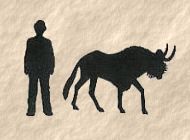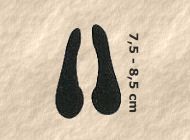 |
 |

Size

Footprint
|
Close this window to go
back to the previous page |
|
Description
|
The colour of the neck, buttocks and back is a
shiny reddish-brown. Halfway down the sides the colour grades to light brown
and then to grey-white on the belly and chest. The eyes are ringed with
white hair and there is a dark spot high on the forehead. The three black
stripes, as seen from behind on the buttocks and the tail, are
characteristic of this species. The animal has scent glands on the ankles of
the hind legs, hidden under a tuft of black hair. The lamb recognises its
mother by her scent. |
|
Sexual dimorphism |
Females lack horns and are smaller than males. |
|
Habitat |
From open well-wooded areas to fairly dense
riverine forest, but usually avoiding mountainous areas. They are dependant
on water. |
|
Habits |
Impala are diurnal, living in herds of
approximately 20 animals. In winter the herds join to form larger herds.
During the mating season the males establish territories. They gather a
group of 15 to 20 females for themselves, chasing other males out of their
territory with a roaring snort. Non-territorial males and juvenile males
form bachelor herds. Impala are very fast and can jump 3 meters high and 12
meters far. Impala can still be found outside conservation areas. |
|
Voice |
A warning or alarm sneeze, and in the mating
season males make a repeated roaring-snort. |
|
Breeding |
A single lamb is born during September to
January after a gestation period of ± 6½ months. |
|
Food |
Leaves and grass. |
|
Mass |
♂ 47 - 82 kg
♀ 32 - 52 kg
|
|
Life expectancy |
± 12 years |
|
Length of horns |
Average ± 50 cm
Record 80,96 cm
|
|
Enemies |
Spotted Hyena, Cheetah, Leopard, Lion, Cape
Hunting Dog, Python. |
|
Also known as |
Rooibok (Afrikaans)
Aepyceros melampus melampus |
|
This
site is best viewed at 1024 X 768
Please report any problems to the Webmaster
Copyright © CoZania October 2004 |



